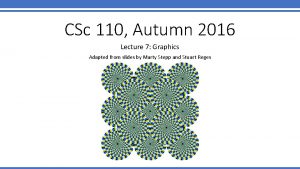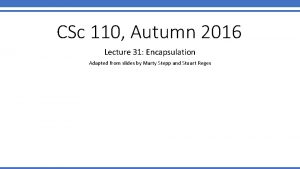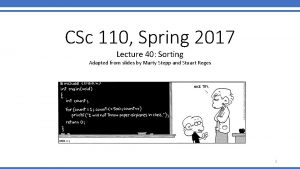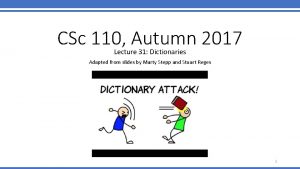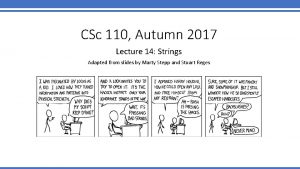CSc 110 Autumn 2016 Lecture 37 Sorting Adapted

















- Slides: 17

CSc 110, Autumn 2016 Lecture 37: Sorting Adapted from slides by Marty Stepp and Stuart Reges

Binary search • Write a function that searches an entire sorted list for a given value and returns the index the value is at, or if it isn't in the list the index it should be inserted at plus one negated. You can assume the list is sorted. index 0 1 2 3 4 5 6 7 8 9 10 11 12 13 14 15 16 value -4 2 7 12 18 25 27 30 36 42 56 68 85 91 92 98 102

Binary search code # Returns the index of an occurrence of target in a, # or a negative number if the target is not found. # Precondition: elements of a are in sorted order def binary_search(a, target): min = 0 max = len(a) - 1 while (min <= max): mid = (min + max) // 2 if (a[mid] < target): min = mid + 1 elif (a[mid] > target): max = mid - 1 else: return mid # target found return -(min + 1) # target not found

Binary search index 0 1 2 3 4 5 6 7 8 9 10 11 12 13 14 15 value -4 2 7 12 18 25 27 30 36 42 56 68 85 91 92 98 102 What do the following calls return when passed the above list? binary_search(a, 2) binary_search(a, 68) binary_search(a, 12) How many comparisons does each call do? 16

Sorting • sorting: Rearranging the values in a list into a specific order (usually into their "natural ordering"). • one of the fundamental problems in computer science • can be solved in many ways: • • • there are many sorting algorithms some are faster/slower than others some use more/less memory than others some work better with specific kinds of data some can utilize multiple computers / processors, . . . • comparison-based sorting : determining order by comparing pairs of elements: • <, >, …

Bogo sort • bogo sort: Orders a list of values by repetitively shuffling them and checking if they are sorted. • name comes from the word "bogus" The algorithm: • Scan the list, seeing if it is sorted. If so, stop. • Else, shuffle the values in the list and repeat. • This sorting algorithm (obviously) has terrible performance!

Bogo sort code # Places the elements of a into sorted order. def bogo_sort(a): while (not is_sorted(a)): shuffle(a) # Swaps a[i] with a[j]. def swap(a, i, j): if (i != j): # Returns true if a's elements temp = a[i] #are in sorted order. a[i] = a[j] def is_sorted(a): a[j] = temp for i in range(0, len(a) - 1): if (a[i] > a[i + 1]): # Shuffles a list by randomly swapping each return False # element with an element ahead of it in the list. return True def shuffle(a): for i in range(0, len(a) - 1): # pick a random index in [i+1, a. length-1] range = len(a) - 1 - (i + 1) + 1 j = (random() * range + (i + 1)) swap(a, i, j)

Selection sort • selection sort: Orders a list of values by repeatedly putting the smallest or largest unplaced value into its final position. The algorithm: • Look through the list to find the smallest value. • Swap it so that it is at index 0. • Look through the list to find the second-smallest value. • Swap it so that it is at index 1. . • Repeat until all values are in their proper places.

Selection sort example • Initial list: index 0 1 2 3 4 5 6 7 8 9 10 11 12 13 14 15 16 value 22 18 12 -4 27 30 36 50 7 68 91 56 7 8 9 10 11 12 13 14 15 16 value -4 18 12 22 27 30 36 50 7 68 91 56 index 0 1 7 8 9 10 11 12 13 14 15 16 value -4 2 12 22 27 30 36 50 7 68 91 56 18 85 42 98 25 index 0 1 2 3 8 9 10 11 12 13 14 15 16 value -4 2 7 22 27 30 36 50 12 68 91 56 18 85 42 98 25 2 85 42 98 25 • After 1 st, 2 nd, and 3 rd passes: index 0 1 2 2 3 3 4 4 4 5 5 5 6 6 6 7 2 85 42 98 25

Selection sort code # Rearranges the elements of a into sorted order using # the selection sort algorithm. def selection_sort(a): for i in range(0, len(a) - 1): # find index of smallest remaining value min = i for j in range(i + 1, len(a)): if (a[j] < a[min]): min = j # swap smallest value its proper place, a[i] swap(a, i, min)

Selection sort runtime (Fig. 13. 6) • How many comparisons does selection sort have to do?

Similar algorithms index 0 1 2 3 4 5 6 7 8 9 10 11 12 13 14 15 16 value 22 18 12 -4 27 30 36 50 7 68 91 56 2 85 42 98 25 �bubble sort: Make repeated passes, swapping adjacent values �slower than selection sort (has to do more swaps) index 0 1 2 3 4 5 6 7 value 18 12 -4 22 27 30 36 7 22 8 9 10 11 12 13 14 15 16 50 68 56 2 50 85 42 91 25 98 91 98 �insertion sort: Shift each element into a sorted sub-list �faster than selection sort (examines fewer values) index 0 1 2 3 4 5 6 7 8 9 10 11 12 13 14 15 16 value -4 12 18 22 27 30 36 50 sorted sub-list (indexes 0 -7) 7 68 91 56 7 2 85 42 98 25

Merge sort • merge sort: Repeatedly divides the data in half, sorts each half, and combines the sorted halves into a sorted whole. The algorithm: • Divide the list into two roughly equal halves. • Sort the left half. • Sort the right half. • Merge the two sorted halves into one sorted list. • Often implemented recursively. • An example of a "divide and conquer" algorithm. • Invented by John von Neumann in 1945

Merge sort example index 0 1 2 3 4 5 6 7 value 22 18 12 -4 58 7 31 42 split 22 18 12 -4 22 18 22 merge 12 -4 split 18 split 12 split -4 merge 58 7 31 42 58 7 58 split 7 merge 18 22 -4 12 merge 31 42 31 merge 7 58 31 42 merge -4 12 18 22 7 31 42 58 merge -4 42 7 12 18 22 31 42 58

Merge halves code # Merges the left/right elements into a sorted result. # Precondition: left/right are sorted def merge(result, left, right): i 1 = 0 # index into left list i 2 = 0 # index into right list for i in range(0, len(result)): if (i 2 >= len(right) or (i 1 < len(left) and left[i 1] <= right[i 2])): result[i] = left[i 1] # take from left i 1 += 1 else: result[i] = right[i 2] # take from right i 2 += 1

Merge sort code # Rearranges the elements of a into sorted order using # the merge sort algorithm. def merge_sort(a): if (len(a) >= 2): # split list into two halves left = a[0, len(a)//2] right = a[len(a)//2, len(a)] # sort the two halves merge_sort(left) merge_sort(right) # merge the sorted halves into a sorted whole merge(a, left, right)

Merge sort runtime • How many comparisons does merge sort have to do?
 Internal and external sorting
Internal and external sorting Vignette mutuelle 110/110
Vignette mutuelle 110/110 011 101 110
011 101 110 Csc 110 university of arizona
Csc 110 university of arizona 01:640:244 lecture notes - lecture 15: plat, idah, farad
01:640:244 lecture notes - lecture 15: plat, idah, farad Approach synoynm
Approach synoynm Camel adaptations for survival
Camel adaptations for survival How have plants adapted to the rainforest
How have plants adapted to the rainforest In what ways have the highland maya adapted to modern life?
In what ways have the highland maya adapted to modern life? How are giraffes long necks adapted to their lifestyle
How are giraffes long necks adapted to their lifestyle Sausage shaped organelles
Sausage shaped organelles This passage is adapted from jane austen
This passage is adapted from jane austen What is spermopsida
What is spermopsida Xerophytic adaptations
Xerophytic adaptations Best brother quotes
Best brother quotes How are red blood cells adapted
How are red blood cells adapted The outsiders adapted for struggling readers
The outsiders adapted for struggling readers Chaparral biome location
Chaparral biome location





















